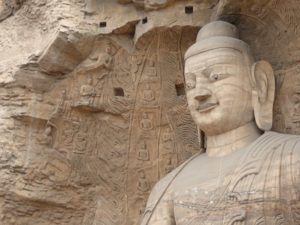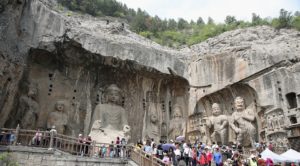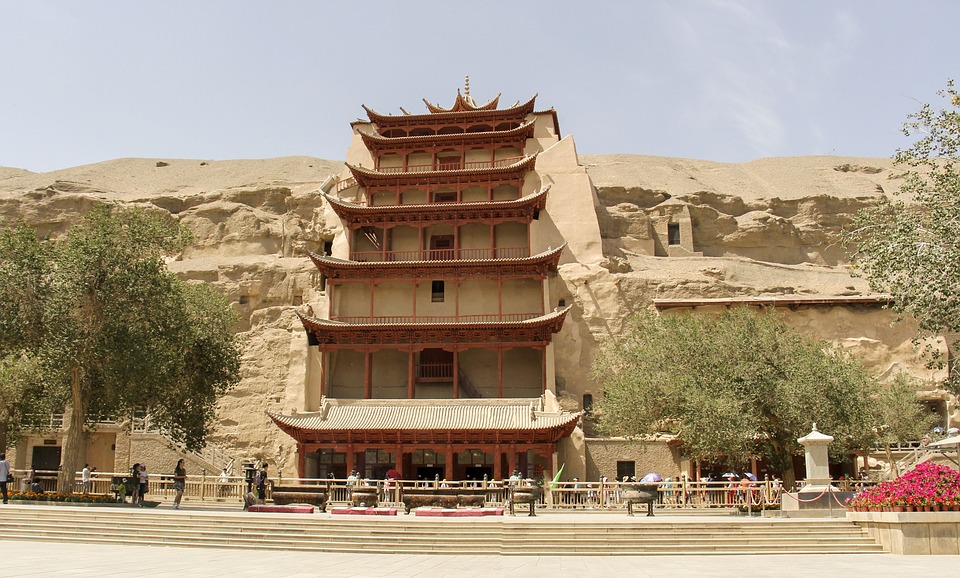When the Silk Road was established in the second century BC, it allowed more than the free flow of goods throughout Asia. It also facilitated cultural exchange between countries that previously had very little contact with each other, and it brought Buddhism to China. The Chinese were very interested in this new religion, and by the first century AD, Buddhism was firmly established there. Along with this new ideology, the Chinese also adopted the Indian tradition of creating Buddhist art in caves—while blending their own artistic style with Buddhist concepts to create unique religious art.
Mogao Caves
As Buddhist monks began traveling to China via the Silk Road, some settled in Dunhuang in modern-day Gansu Province. In 366 AD, the monks started digging the first cave of the monumental Mogao grottoes for their worship and lodging. Over time, caravans following the Silk Road began stopping at the site before continuing on to the capital of Chang’an, and wealthy merchants and officials funded the construction of new caves. The Mogao Caves reached their zenith during the Tang Dynasty (618-907), but when trade along the Silk Road collapsed, the 1,700-meter site was forgotten.
The murals and terra cotta statues of the caves show the change in styles that occurred over time. The earliest caves contain thin and ghostly Buddhist imagery, which is distinctly Indian in style. However, by the Sui and Tang Dynasties, the style had taken on the characteristics of Chinese art. One noticeable deviation from Indian imagery is the Chinese depiction of Guanyin as female, instead of male. Highlights of the Mogao Caves include two giant Buddha statues and the Library Cave, which contained tens of thousands of well-preserved manuscripts and records in many different Asian languages. Although Dunhuang is in a distant and isolated location, it is fundamental to the current understanding of the spread and evolution of Buddhism in China.
Yungang Caves
 When the Tuoba people came to power and formed the Northern Wei Dynasty (386-534), they began building the Yungang Caves in Datong, Shanxi Province. These caves, which were begun around 460, feature some of the earliest Buddhist carvings in China. They may have chosen to work in stone because of the durability of rock as compared to wooden images, which were easily destroyed during periods of persecution against Buddhists. Unfortunately, sandstone is easily damaged by erosion, although there have been several attempts overtime to preserve this important site.
When the Tuoba people came to power and formed the Northern Wei Dynasty (386-534), they began building the Yungang Caves in Datong, Shanxi Province. These caves, which were begun around 460, feature some of the earliest Buddhist carvings in China. They may have chosen to work in stone because of the durability of rock as compared to wooden images, which were easily destroyed during periods of persecution against Buddhists. Unfortunately, sandstone is easily damaged by erosion, although there have been several attempts overtime to preserve this important site.
The Yungang Caves contain 21 main grottoes carved over one kilometer of sandstone cliffs. Some caves feature giant Buddhas, which were carved with the faces of Northern Wei emperors who claimed to be reincarnations of Buddha. In some of the caves, Hindu gods are presented alongside traditional Chinese images, such as the phoenix and dragon.
Longmen Caves
 The Longmen Caves were the last major Buddhist grottoes to be constructed. Work began in 493, when the Northern Wei Dynasty moved its capital to Luoyang, Henan Province. This site contains more than 100,000 Buddhist images along one kilometer of the Yi River. Longmen is notable for its carefully chiseled limestone statues, which are still marked with the names of the patrons who commissioned them. Much of the work begun at this site was completed during the Tang Dynasty, although it features the Northern Wei style.
The Longmen Caves were the last major Buddhist grottoes to be constructed. Work began in 493, when the Northern Wei Dynasty moved its capital to Luoyang, Henan Province. This site contains more than 100,000 Buddhist images along one kilometer of the Yi River. Longmen is notable for its carefully chiseled limestone statues, which are still marked with the names of the patrons who commissioned them. Much of the work begun at this site was completed during the Tang Dynasty, although it features the Northern Wei style.
The Longmen Caves contain several notable grottoes of stone carvings. The Ancestor Worshipping Temple (Fengxian Temple) is the largest grotto on the site, and it contains a giant seated statue of Buddha. The face of this statue is supposedly modeled on the Tang Dynasty Empress Wu Zetian. Other important grottoes include the Ten Thousand Buddha Cave, with its gallery of bas-relief Buddhas, and the Three Binyang Caves. Unfortunately, the Longmen Caves have suffered extensive damage over the years. Some statues were beheaded by foreign explorers and sent abroad, and others were defaced by zealous Chinese during the Cultural Revolution.
All three of these sites demonstrate the importance of Buddhism in China (despite its foreign heritage), and the artistic development it inspired. Although not located in places easily accessible to the average tourist, all of these sites are open to the public and they are a worthwhile addition to a trip to China.





